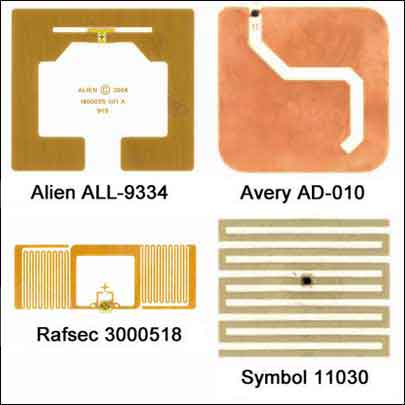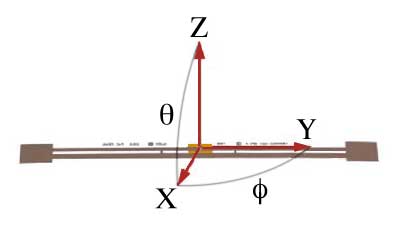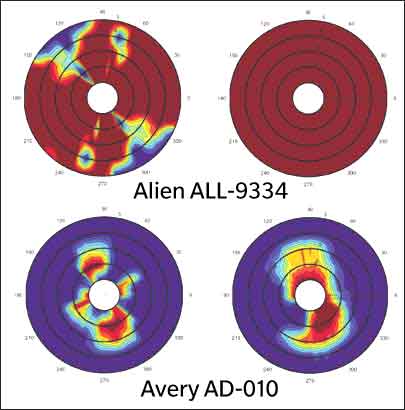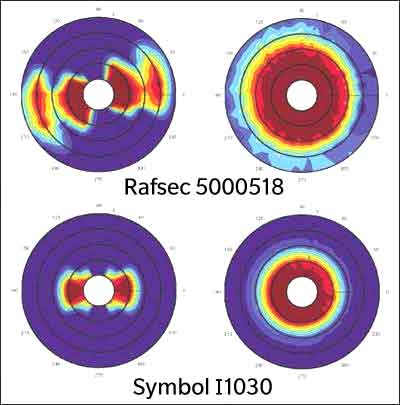Many companies are anticipating the time when they will tag unique items, but they are not sure about the performance of UHF tags that conform to Electronic Product Code specifications. One such company in the Kansas City area asked the RFID Alliance Lab, a not-for-profit facility, to test the tagging of cell phones. Our tests revealed some startlingly large differences in performance among the tags, with no clear winners or losers. The tag’s size, read distance and orientation with the interrogator all affect performance. (For a discussion on whether HF is a better technology for item-level tagging, see sidebar at end of article.)
We tested four commercially available RFID tags that are based on EPCglobal‘s Gen 1 air-interface protocol specifications and smaller than 2 inches by 2 inches, so they’d fit on a PDA or cell phone: Alien ALL-9334, Avery Dennison AD-010, Rafsec 3000518 and Symbol I1030. At the time we did the testing, we were not able to obtain a sufficient quantity of any Gen 2 tags. While we expect Gen 2 tags to perform better than their Gen 1 counterparts, we believe that our general conclusions will hold.
|
|
• The Alien ALL-9334 was the largest tag we tested. The entire label, including the antenna and a small margin, measured 50 mm (2.0 inches) by 48 mm (1.9 inches). The Alien tag has a 96-bit Class 1 chip encased in a strap, which has leads that connect the chip to metal pads; the pads attach to the antenna. We tested 20 of these tags.
• The Avery AD-010 is a 96-bit Class 1 tag. The tags we tested came from a spool of 200 tags in the form of unconverted inlays. The inlay measured 33 mm (1.3 inches) by 33 mm. (We prefer to test converted labels, because the conversion process can impact yield and performance, but time pressures forced a compromise.) Roughly half the tags were marked with a black dot, indicating the tag had failed quality standards; we did not test these tags.
• The Rafsec 3000518 is a 96-bit Class 1 tag. The entire label measures 15 mm (0.6 inch) by 35 mm (1.4 inches). We obtained two rolls of 100 labels each, of which 50 were used in these tests.
• The Symbol I1030 is a 64-bit Class 0 read-only tag. The entire self-adhesive inlay measures 37 mm (1.5 inches) by 30 mm (1.2 inches). We tested 50 tags.In this report, we focus on two of the most important metrics for tag performance: read distance and orientation sensitivity. Read distance is simply how far away a standard interrogator can read a tag. Orientation sensitivity means how much the read performance degrades when the orientation, or angle, of the tag to the interrogator changes. An orientation-insensitive tag will work the same way regardless of how the tag is rotated. An orientation-sensitive tag will work well at some angles, but it may become completely invisible at other angles.
The size of that “angle of invisibility” is called the null zone of the tag. If you can’t control the orientation of the tag, large null zones can be problematic because you won’t be able to read the tag. If the tag is moving so that the orientation changes over time, the problem of null zones may be mitigated.

How We Tested
Although our results may indicate that a tag meets your requirements, do not assume it will. We tested the tags in an ideal setting—with no other tags in the vicinity—which means that there was no interference. Real operating environments may be noisy, especially if there are other interrogators nearby.
For all our tests, we used a ThingMagic Mercury4 interrogator with a circularly polarized bistatic antenna. A bistatic antenna has two antennas: one transmits, the other receives. (We chose a Mercury4 because it is well respected in the industry, and ThingMagic is not a tag manufacturer, so there’s less chance that its product is optimized to work well with one brand of tag.) The Mercury4 has few parameters to set, and the identical setting was used for all the tags. The interrogator was set to emit the maximum power allowable under U.S. Federal Communications Commission regulations—the setting that will give the best performance results. Smaller handheld interrogators will not give the same performance.
The way in which the tag and interrogator antenna were oriented is important. We chose the setup that would give the best performance because circularly polarized antennas are not purely circular, and small amounts of cross-polarization (think “elliptical”) can favor one orientation over another. We tested performance by placing the tag in three different positions relative to the interrogator antennas: directly in front of the transmit antenna, directly in front of the receive antenna, and halfway between the transmit and receive antennas. Of those three positions, we found that placing the tag directly in front of the transmit antenna gave the best performance, so that is how we tested the tags.We wanted to measure two things: how well the interrogator can read the tag from various distances, and how the orientation of the tag impacts read distance. To obtain that data, we placed the tag at varying distances from the interrogator’s transmit antenna—from 1 to 5 feet, in 1-foot intervals. Then, to understand the impact of orientation, we rotated the tag along two angles at 5-degree increments or less. Next, at each distance and angle, we performed 100 read attempts and recorded the number of successful reads. All told, we performed at least 72,000 read attempts for each tag.
For any object in space, there are three angles of rotation. The X and Y axes form the E-plane (E stands for “electric field”), and rotations in that plane are defined by the Greek letter f. The X and Z axes form the H-plane (H stands for “magnetic intensity”), and rotations in that plane are defined by the Greek letter q. These two angles and planes represent the different ways that we rotated the tag at different distances.

The third plane, defined by the Y and Z axes, is the polarization plane. If the interrogator antennas are circularly polarized, the orientation in the Y-Z plane should not matter. But we found that the Mercury4 antennas were not completely circularly polarized. The Mercury4 was better able to read the tag when the long dimension of the tag and interrogator antennas were perpendicular rather than parallel with each other. Therefore, all our measurements were taken with the tags and antennas perpendicular. What this means is that the quality and polarization of interrogator antennas can have a substantial impact on tag performance.
What We Found
We plotted our test results using a color-coded polar plot that we call a radiation pattern. The distance between the tag and interrogator transmit antenna is represented by concentric circles; circles farther away from the middle represent larger distances between the tag and interrogator. The angle in the plot represents how we rotated the tag.
The colors in “Color Code for Response Rate” correspond to the percent of responses at a distance and orientation. Between data points, we used a simple linear interpolation. So, for example, the Rafsec tag was readable about 100 percent at a distance 2 feet away and rotated at an angle of 60 degrees in the E-plane. The tag becomes unreadable when rotated to 90 degrees, or rotated 60 degrees, and placed 3 feet away.Look for lots of dark red in the radiation pattern. The Alien H-plane is an example of the perfect response: At every distance and every orientation, we were able to read a tag 100 times out of 100 attempts. In contrast, the Symbol H-plane shows lots of dark blue, which represent distances and orientations in which the tag is unreadable (zero out of 100 attempts).
Based on our tests, there are two ways to measure the quality of the tag. For the farthest read distance, look for the biggest circle that has red on it. For orientation sensitivity, look for circular patterns, such as those in the Symbol H-plane, which are ideal because the tag will perform the same regardless of how it is rotated in that plane. But the Symbol E-plane shows that the tag has two large angles, or null zones, in which it is unreadable even 1 foot away.

Overall, we saw a set of tradeoffs, with no clear winners and losers. The Alien ALL-9334 was clearly the best performing tag, but its size—by far the largest tag we tested—makes it unsuitable for many item-level applications. Still, it does emphasize an important general principle: Bigger tags, in general, perform better, because antenna performance is roughly proportional to the size of the antenna.
The performance we observed with this tag is comparable with that of tags with a 1-by 4-inch form factor, such as the Alien Squiggle. The ALL-9334 has a nearly perfect radiation pattern in the E-plane with very small null zones (the null zones are likely to become more pronounced at larger distances, which should not be a concern for item-level tags). The H-plane performance was ideal.
The read distance of the Avery AD-010 was good, not great, practically limited to 3 feet. But the real benefit of this tag is its radiation pattern. While the radiation pattern isn’t circular in either plane, perhaps more important, there is only one large null zone in the H-plane. There are many small null zones, but they are comparatively narrow, which is, in general, more desirable than large null zones.For its size, the Rafsec 3000518 was clearly an excellent performer in terms of read distance. In some orientations, we had strong reads at 4 feet, and in other tests, we read the tag as far as 7 feet away. It does have two large null zones centered at 105 degrees and 285 degrees in the E-plane. The nulls in the radiation pattern are considerable and must be managed. In other tests, we found that performance did degrade slightly at the higher frequencies used in the United States, and barely worked at all at 953 MHz, a frequency used in some parts of Asia. Rafsec does not market this tag for Asian companies.
The Symbol I1030 had the worst overall performance, barely readable at 3 feet, and the radiation pattern (similar to the Rafsec) showed large null zones centered at 90 degrees and 270 degrees in the E-plane. It is probably using the oldest and least efficient microchip, which might account for the poor relative performance.

HF vs. UHF for Tagging Items
HF stands for high frequency, which for passive RFID systems represents a region centered at 13.56 MHz. UHF stands for ultra high frequency; for passive RFID, it’s the various open bands worldwide between 860 MHz and 960 MHz. (In the United States, the UHF interrogators operate between 902 MHz and 928 MHz.) Different radio frequencies have different characteristics and different properties. Over short distances, HF systems are much more robust in that they are less affected by water, metal and densely packed tags. But after a certain distance, HF performance drops off precipitously.
UHF performance also drops off with distance, but not as rapidly. Some larger passive UHF tags can be read under ideal conditions from almost 35 feet away, for example, while HF tags are often limited to about 3 feet.
But UHF suffers from a number of problems. Highly dielectric materials (liquids) and conductors (metal), even in small amounts, can drastically change the properties of a tag antenna, reducing efficiency and shortening the read distance, sometimes to the point of becoming completely unreadable at any distance. Also, two UHF tags that are too close can interfere with each other. This is especially evident when small tags are stacked closely, such as when numerous tagged items are in a case.Which technology is better—HF or UHF? This is not an easy question to answer because there are both business and technical issues that need to be considered. If you are installing a network of UHF interrogators for reading case and pallet tags, it might be cost-effective to use the same network to read item-level tags. But the distance from which you need to read the tags, the nature of the items you are tagging and the environment in which you are reading the tags will have an impact on which frequency you need to adopt.
For read distances beyond 6 feet, UHF is the clear winner. But for short read distances in difficult environments, such as on products containing water or metal, HF will perform better. And for long read distances in difficult environments, neither may work. In challenging environments, you may need to look at active tags (with batteries and transmitters) or semi-passive tags (with batteries but no transmitters), but these options are often more expensive than passive tags.

Conclusions
Item-level tags come in different sizes. Some are nearly 50 mm square, and some are as small as 15 mm by 35 mm. All other things being equal, in general, bigger tags perform better. But, interestingly, the second best-performing tag is also the smallest.
The performance of item-level tags is only a fraction of that of their larger case- and pallet-level cousins. We have read some case and pallet tags more than 30 feet away, for example, while two of the four item-level tags that we tested are virtually unreadable at 4 feet or more.
Keep in mind your requirements. If you need only 6 inches of read distance and can control the orientation, any of these tags might be suitable. But these tags were tested in free space, away from any interference. Performance can degrade when tags are placed on various materials, or if several tags are in close proximity (within a few inches). Also, there are manufacturing variances, so not all tags of the same model perform identically; you may need to plan on having some margin in the performance budget. (The results we present here are from a median-performing tag from a sample of at least 20 tags.)
Choosing among the four UHF RFID tags we tested will depend on many factors, and obviously, every application is different. The most common decision process is likely to be: Will the Alien ALL-9334 fit or is it too big? If it fits, use it. If not, can a null in the radiation pattern be managed? If not, the Avery AD-010 might be a better choice, since the Avery tag lacks two large null zones in any one plane, as is the case with the other tags. If so, then can a small failure rate be managed? If the answer is yes, the Rafsec 3000518 tag is probably the best choice; otherwise, the Symbol I1030 tag may work.
Daniel Deavours, Ph.D., is the research director of the RFID Alliance Lab, which is dedicated to unbiased testing of RFID products. The RFID Alliance Lab performs testing at the University of Kansas and is supported by Rush Tracking Systems of Lenexa, Kansas, and RFID Journal. To learn more about the lab, purchase reports or find out how the lab can help you with a special need, go to www.rfidjournal.com/labreports.


